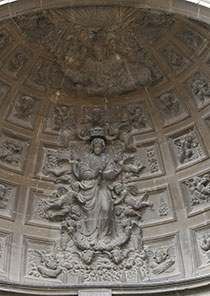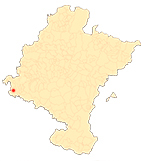Front façade of the parish church of Santa María de Viana
Assumption - Coronation of the Virgin
In the quarter-sphere vault that crowns the central body of the façade, covered with coffers inscribed with figures of little angels and cherubs, we find the representation of the Assumption and the Coronation of the Virgin on the same group . Thus, on the ascending axis of the Holy Family, Calvary and the Holy Burial, the image of Our Lady is placed, ascended to heaven by the figures of several angels, with her feet on the moon average , supported by a glory of clouds, thus marking the fact that the Virgin did not ascend to heaven by her own means, but was carried by angels. The image is depicted in a tunic with v-shaped folds, with her knees bent, her hands clasped on her chest in prayerful pose and her head bowed downwards in a sign of humility. This is an iconography that would give way to that of the Immaculate Conception, with which it is already confused in its forms of representation. In this image we see how, at the same time as her assumption, her coronation takes place, with two angels placing a royal crown on her, while at the top we see the figure of the Eternal Father, in an attitude of blessing with his right hand and holding the orb in his left, also surrounded by a glory of clouds and angels.
The figure of the Virgin appears here playing a preponderant role in the message of redemption, as the intercessor of men before her son, being at the same time the daughter of Zacharias and a descendant of David. The importance of her role as co-redeemer is reflected in her assumption into heaven and her coronation by the Eternal Father, two themes that form part of the cycle of the Glorification of the Virgin.
-
ESTEBAN LORENTE, J.F., "El arco de ingreso de la colegiata de Santa María de Viana. Horóscopo de Cristo", Berceo, 130, 1996, pp. 177-178.
-
ESTEBAN LORENTE, J.F., "Los dioses paganos en las iglesias españolas del siglo XVI", bulletin del Museo e high school Camón Aznar, LXXXII, Zaragoza, high school Camón Aznar, 2000, pp. 157-190.
-
FERNÁNDEZ GRACIA, R., (coord.), ECHEVERRIA GOÑI, P.L., and GARCÍA GAINZA, M. C., El arte del Renacimiento en Navarra, Pamplona, Gobierno de Navarra, 2005, pp. 111-114.
-
GARCÍA GAINZA, M. C., HEREDIA MORENO, M. C., RIVAS CARMONA, J. and ORBE SIVATTE, M., Catalog Monumental de Navarra. V. II**. Merindad de Estella, Pamplona, 1980, pp. 559-564.
-
GONZÁLEZ DE ZÁRATE, J. M., "Aproximaciones a la lectura iconográfica del programa mitológico en la portada de Santa María de Viana", Primer congress General de Historia de Navarra, anejo 11, Pamplona, Príncipe de Viana, 1988, pp. 179-196.
-
LABEAGA MENDIOLA, J.C., Viana monumental y artística, Pamplona, Príncipe de Viana, 1984, pp. 229-236.












